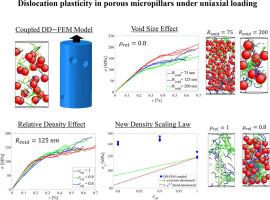Dislocation plasticity in porous micropillars under uniaxial loading
IF 14.3
1区 材料科学
Q1 MATERIALS SCIENCE, MULTIDISCIPLINARY
引用次数: 0
Abstract
A mesoscale computational plasticity model, which concurrently couples dislocation dynamics and the finite element method, has been developed to investigate fundamental deformation mechanisms and the corresponding mechanical response of single-crystalline aluminum porous micropillars. In this study, we explore the deformation mechanisms for incipient plasticity and the size-dependent strengthening properties in nanoporous metals under the complex loading conditions from the porous geometry. At a small scale where plastic deformation is governed by the operation of dislocation sources, the presence of nanovoids could even increase the flow stress by shortening the source length, which could also effectively hinder easy glide motion. Interestingly, nanoporous micropillars could achieve even higher strength than the bulk strength, as observed in recent experiments. In this regard, the flow stress shows clear dependence on not only macroscopic features of relative density, but also microscopic features such as the size and shape of the nanovoids. Our coupled model could provide unique opportunities for predicting macroscopic mechanical properties through the fundamental understanding of microscopic deformation mechanisms, showing good agreement with recent experimental results of nanoarchitecture materials.

单轴加载下多孔微柱的位错塑性
建立了位错动力学和有限元方法相结合的中尺度计算塑性模型,研究了单晶铝多孔微柱的基本变形机制和相应的力学响应。在本研究中,我们从多孔几何角度探讨了复杂载荷条件下纳米多孔金属的初始塑性变形机制和尺寸依赖性强化特性。在小尺度下,塑性变形由位错源的作用控制,纳米空洞的存在甚至可以通过缩短位错源的长度来增加流动应力,这也可以有效地阻碍容易的滑动运动。有趣的是,在最近的实验中观察到,纳米多孔微柱的强度甚至比体积强度更高。在这方面,流动应力不仅与相对密度的宏观特征有关,而且与纳米孔的大小和形状等微观特征有关。我们的耦合模型可以通过对微观变形机制的基本理解,为预测宏观力学性能提供独特的机会,与纳米结构材料的最新实验结果显示出良好的一致性。
本文章由计算机程序翻译,如有差异,请以英文原文为准。
求助全文
约1分钟内获得全文
求助全文
来源期刊

Journal of Materials Science & Technology
工程技术-材料科学:综合
CiteScore
20.00
自引率
11.00%
发文量
995
审稿时长
13 days
期刊介绍:
Journal of Materials Science & Technology strives to promote global collaboration in the field of materials science and technology. It primarily publishes original research papers, invited review articles, letters, research notes, and summaries of scientific achievements. The journal covers a wide range of materials science and technology topics, including metallic materials, inorganic nonmetallic materials, and composite materials.
 求助内容:
求助内容: 应助结果提醒方式:
应助结果提醒方式:


